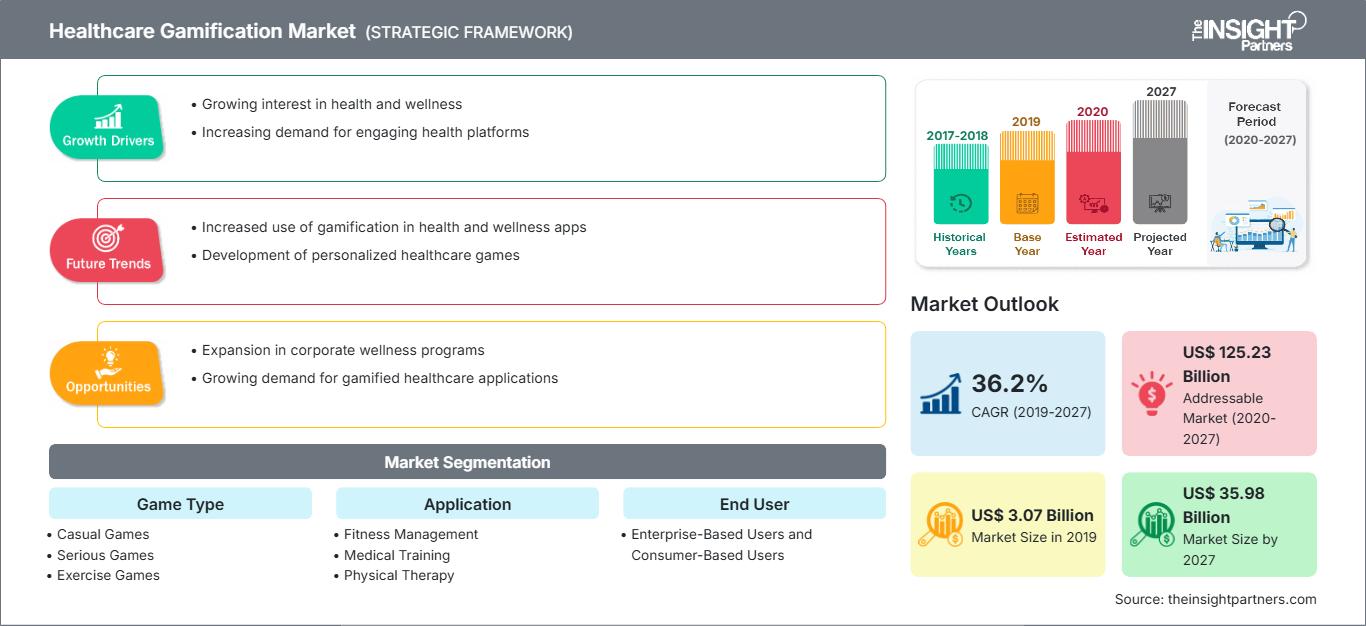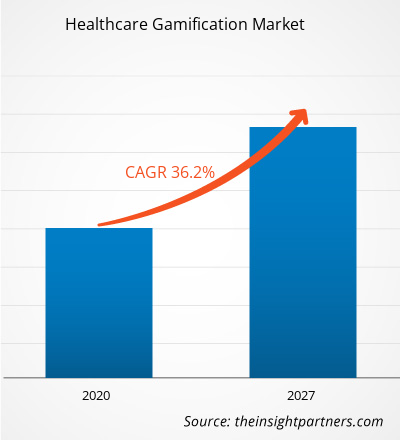[Forschungsbericht]Der Markt für Gamification im Gesundheitswesen wird voraussichtlich von 3.072,5 Millionen US-Dollar im Jahr 2019 auf 35.982,7 Millionen US-Dollar im Jahr 2027 anwachsen. Von 2020 bis 2027 wird ein durchschnittliches jährliches Wachstum von 36,2 % erwartet.
Das Marktwachstum ist auf Faktoren wie die zunehmende Nutzung von Gamification im Gesundheitswesen und die steigende Anzahl neuer Technologien zurückzuführen. Schwierigkeiten bei der langfristigen Nutzerbindung werden das Marktwachstum jedoch voraussichtlich hemmen.
Markteinblicke: Zunehmende Nutzung von Gamification im Gesundheitswesen
Spiele wurden bereits 1975 in die Gesundheitsbehandlung eingeführt und spielten in der Spieltherapie eine wichtige Rolle. Darüber hinaus haben Spiele in jüngster Zeit durch die Integration von künstlicher Intelligenz und erweiterter Realität in den Gesundheitssektor auch im Hinblick auf therapeutische Aspekte an Bedeutung gewonnen. Die Spiele bieten den Patienten die Möglichkeit, sich auszudrücken, was den meisten Patienten sonst nicht möglich ist, und helfen so den Fachkräften, eine bessere Therapie zu entwickeln, die zu effektiveren Behandlungsergebnissen führt. Daher wird erwartet, dass die steigende Prävalenz chronischer Krankheiten wie psychischer Erkrankungen sowie Muskel-Skelett- und orthopädischer Leiden, die bis zu einem gewissen Grad mit Gaming-Technologien behandelbar sind, die Nachfrage nach Gamification im Gesundheitswesen stark ansteigen lässt. Gaming-Therapie hat sich als hilfreich bei der Behandlung junger Patienten erwiesen, die es gewohnt sind, ihr Leben lang ständig mit Technologie zu interagieren. Darüber hinaus unterstützt die Einführung neuer Technologien wie Augmented Reality (AR) und Virtual Reality (VR) im Gesundheitswesen die Fachkräfte bei der Behandlung psychischer Erkrankungen von Patienten und unterstützt sie bei Beratungsgesprächen. So führte beispielsweise ein Team von Spieleentwicklern in den USA im Jahr 2016 ein DEEP-VR-Erlebnis ein, das Benutzer in einer Unterwasserumgebung anleitet, um die Symptome von Angst und Stress zu erlernen und zu bekämpfen. Darüber hinaus ermöglicht die Einbeziehung körperlicher Aktivitäten in Videospiele die Integration von VR in Rehabilitationstherapien. So entwickelten Studierende der Rice University im Oktober 2017 das Videospiel Equilibrium für die pädiatrische Physiotherapie. Das Spiel nutzt das Wii Balance Board und speziell entwickelte Balancestäbe, die Kinder für die Verbesserung ihrer Gehfähigkeit und das Erlernen des Gleichgewichts begeistern. Die zunehmende Nutzung von Gamification zu therapeutischen Zwecken treibt somit das Wachstum des Gamification-Marktes im Gesundheitswesen voran.
Passen Sie diesen Bericht Ihren Anforderungen an
Sie erhalten kostenlos Anpassungen an jedem Bericht, einschließlich Teilen dieses Berichts oder einer Analyse auf Länderebene, eines Excel-Datenpakets sowie tolle Angebote und Rabatte für Start-ups und Universitäten.
Markt für Gamification im Gesundheitswesen: Strategische Einblicke

-
Holen Sie sich die wichtigsten Markttrends aus diesem Bericht.Dieses KOSTENLOSE Beispiel umfasst Datenanalysen, die von Markttrends bis hin zu Schätzungen und Prognosen reichen.
Erkenntnisse nach Spieltypen
Basierend auf dem Spieltyp ist der Gamification-Markt im Gesundheitswesen in Casual Games, Serious Games und Bewegungsspiele unterteilt. Im Jahr 2019 hatten Casual Games den größten Marktanteil, da sie aufgrund ihrer positiven Wirkung auf die Verbesserung kognitiver Fähigkeiten zunehmend von Kindern und älteren Menschen über 50 Jahren angenommen werden. Die wachsende Nachfrage treibt Unternehmen dazu, eine große Palette unterhaltsamer Casual Games anzubieten. In den prognostizierten Jahren wird jedoch erwartet, dass Bewegungsspiele schneller wachsen, da sie Fitness- und interaktive Bewegungsspiele umfassen. Andererseits haben viele Gesundheitsdienstleister mit Bewegungs-Apps zusammengearbeitet, um gesunde Gewohnheiten bei den Benutzern zu fördern. So hat beispielsweise der Gesundheitsriese United Healthcare bei einem Pilotprogramm mit den Machern von „Dance, Dance Revolution“ zusammengearbeitet. an einem sportunterrichtsfreundlichen Spiel, um Kinder auf den Beinen und vom Sofa fernzuhalten.
Anwendungsbasierte Erkenntnisse
Der Gamification-Markt im Gesundheitswesen ist nach Anwendung segmentiert in Fitnessmanagement, medizinisches Training, Physiotherapie und Sonstiges. Das Segment Fitnessmanagement hatte 2019 den größten Marktanteil. Außerdem wird für dasselbe Segment im Prognosezeitraum die höchste durchschnittliche jährliche Wachstumsrate (CAGR) erwartet.
Endbenutzerbasierte Erkenntnisse
Basierend auf dem Endbenutzer ist der Gamification-Markt im Gesundheitswesen segmentiert in unternehmensbasierte Benutzer und verbraucherbasierte Benutzer. Das Segment der unternehmensbasierten Nutzer hatte 2019 den größten Marktanteil und wird im Prognosezeitraum voraussichtlich die höchste durchschnittliche jährliche Wachstumsrate (CAGR) verzeichnen.
Akteure im Bereich Gamification im Gesundheitswesen wie Cognifit, Mango Health, Bunchball, Ayogo Health Inc., .Fitbit, Inc., Akili Interactive Labs, Inc., Nike, Inc., Cohero Health, Inc., Higi Sh Llc und Mysugr verfolgen verschiedene organische und anorganische Strategien zur Verbesserung ihrer Umsätze und Marktposition. So brachte TrialCard Incorporated im Oktober 2020 Version 2.0 von Mango Health auf den Markt. Diese neueste Version bietet externen Gesundheitsdienstleistern Zugriff auf Mangos umfangreiche Patientensupport-Module. Diese neueste Version der Mango-Plattform wird Teil eines vollständig integrierten Patientensupport-Programms für die bevorstehende Markteinführung eines neuartigen oralen Onkolytikums sein.
Gamification im Gesundheitswesen
Regionale Einblicke in den Gamification-Markt im GesundheitswesenDie Analysten von The Insight Partners haben die regionalen Trends und Faktoren, die den Markt für Gamification im Gesundheitswesen im Prognosezeitraum beeinflussen, ausführlich erläutert. In diesem Abschnitt werden auch die Marktsegmente und die geografische Lage im Bereich Gamification im Gesundheitswesen in Nordamerika, Europa, im asiatisch-pazifischen Raum, im Nahen Osten und Afrika sowie in Süd- und Mittelamerika erörtert.
Umfang des Gamification-Marktberichts im Gesundheitswesen
| Berichtsattribut | Einzelheiten |
|---|---|
| Marktgröße in 2019 | US$ 3.07 Billion |
| Marktgröße nach 2027 | US$ 35.98 Billion |
| Globale CAGR (2019 - 2027) | 36.2% |
| Historische Daten | 2017-2018 |
| Prognosezeitraum | 2020-2027 |
| Abgedeckte Segmente |
By Spieltyp
|
| Abgedeckte Regionen und Länder |
Nordamerika
|
| Marktführer und wichtige Unternehmensprofile |
|
Dichte der Marktteilnehmer im Bereich Gamification im Gesundheitswesen: Verständnis ihrer Auswirkungen auf die Geschäftsdynamik
Der Gamification-Markt im Gesundheitswesen wächst rasant. Dies wird durch die steigende Nachfrage der Endnutzer aufgrund veränderter Verbraucherpräferenzen, technologischer Fortschritte und eines stärkeren Bewusstseins für die Produktvorteile vorangetrieben. Mit der steigenden Nachfrage erweitern Unternehmen ihr Angebot, entwickeln Innovationen, um den Bedürfnissen der Verbraucher gerecht zu werden, und nutzen neue Trends, was das Marktwachstum weiter ankurbelt.

- Holen Sie sich die Markt für Gamification im Gesundheitswesen Übersicht der wichtigsten Akteure
Gamification-Markt im Gesundheitswesen – nach Spieltyp
- Casual Games
- Serious Games
- Trainingsspiele
Gamification-Markt im Gesundheitswesen – nach Anwendung
- Fitnessmanagement
- Medizinische Ausbildung
- Physiotherapie
- Sonstige
Gamification-Markt im Gesundheitswesen – nach Endbenutzer
- Unternehmensbasierte Benutzer
- Verbraucherbasierte Benutzer
Gamification-Markt im Gesundheitswesen – nach Geografie
-
Nordamerika
- USA
- Kanada
- Mexiko
-
Europa
- Frankreich
- Deutschland
- Italien
- Vereinigtes Königreich
- Spanien
- Rest von Europa
-
Asien-Pazifik (APAC)
- China
- Indien
- Südkorea
- Japan
- Australien
- Übriger Asien-Pazifik
-
Naher Osten und Afrika (MEA)
- Südafrika
- Saudi Arabien
- VAE
- Restlicher Naher Osten &Afrika
-
Süd- und Mittelamerika
- Brasilien
- Argentinien
- Übriges Süd- und Mittelamerika
Unternehmensprofile
- Cognifit
- Mango Health
- Bunchball
- Ayogo Health Inc.
- Fitbit, Inc.
- Akili Interactive Labs, Inc.
- Nike, Inc.
- Cohero Health, Inc.
- Higi Sh Llc
- Mysugr
- Historische Analyse (2 Jahre), Basisjahr, Prognose (7 Jahre) mit CAGR
- PEST- und SWOT-Analyse
- Marktgröße Wert/Volumen – Global, Regional, Land
- Branchen- und Wettbewerbslandschaft
- Excel-Datensatz
Aktuelle Berichte
Verwandte Berichte
Erfahrungsberichte
Grund zum Kauf
- Fundierte Entscheidungsfindung
- Marktdynamik verstehen
- Wettbewerbsanalyse
- Kundeneinblicke
- Marktprognosen
- Risikominimierung
- Strategische Planung
- Investitionsbegründung
- Identifizierung neuer Märkte
- Verbesserung von Marketingstrategien
- Steigerung der Betriebseffizienz
- Anpassung an regulatorische Trends






















 Kostenlose Probe anfordern für - Markt für Gamification im Gesundheitswesen
Kostenlose Probe anfordern für - Markt für Gamification im Gesundheitswesen